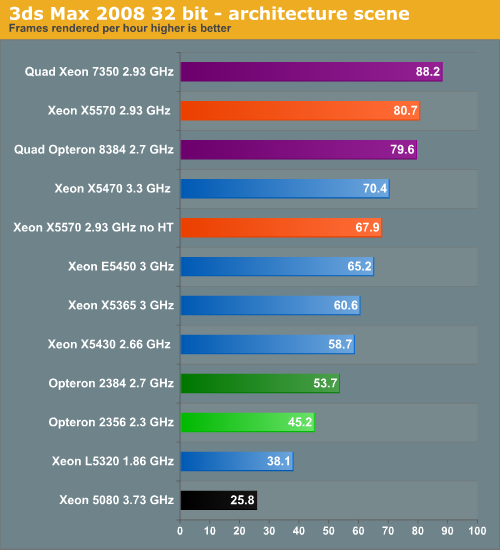The Best Server CPUs part 2: the Intel "Nehalem" Xeon X5570
by Johan De Gelas on March 30, 2009 3:00 PM EST- Posted in
- IT Computing
| Rendering: 3ds Max 2008 | |
| Operating System | Windows 2008 Enterprise RTM (64-bit) |
| Software | 3ds Max 2008 |
| Benchmark software | Build in timer |
| Typical error margin | 1-2% |
Render server are only a small part of the server market. We used the "architecture" scene included in the SPEC APC 3DS Max test. All tests were done with 3ds max's default scanline renderer, SSE enabled, and we rendered at HD 720p (1280x720) resolution. We measured the time it takes to render 10 frames (from 20 to 29) and then calculated (3600 seconds * 10 frames / time recorded) how many frames a certain CPU configuration could render in one hour. Results are reported as rendered images per hour.

We used the 32-bit version of 3ds Max 2008 on 64-bit Windows 2008 RTM. The 64-bit version of Windows 2008 is a bit slower (especially when you use the scanline renderer). All CPU configurations are dual, unless we indicate otherwise.

When it comes to floating point and SSE, the performance gains over several CPU generations are a bit smaller. The Xeon 5570 again shatters all records, but it's "only" three times faster than the Xeon 5080. There are two reasons for this. First, the Xeon 5080 is based on the Pentium 4 architecture. Thanks to its high clock speed, it can deliver relatively high FLOPS (Floating Point Operations per Second). The high branch prediction penalty, the relatively low hit rate of the trace cache, and very high memory latency which all made the Pentium 4 based Xeons very inefficient in integer code are of no real importance when running floating point intensive applications such as 3ds Max.
Improvements have been slower in this area. In the Xeon 51xx we have seen the introduction of 128-bit SSE units (AMD: Barcelona, Opteron 23xx) and faster 4-bit RADIX in the Harpertown Xeon (Xeon 54xx). We analyzed this in great detail previously: while the Opterons are still better at divisions, the Xeon 54xx is faster in multiplications which are much more common. The Xeon 55x "Nehalem" is almost identical to the Xeon 54xx "Harpertown", while the AMD "Shanghai" is identical to AMD "Barcelona" core when it comes to floating point. Notice how the Nehalem at 2.93GHz (in reality 3.1GHz) settles between the 3GHz and 3.3GHz Xeon 54xx. This confirms that floating point code hardly sees a difference between a Harpertown and a Nehalem… unless it is limited by the bandwidth available to the core of course. Nehalem can still beat its older brothers thanks to SMT, once again underlining what a powerful weapon SMT is.
While the Xeon X5570 is only 24% faster than the Xeon 5450, that is good enough to make the current 4-way servers completely useless for rendering. The dual Xeon "Nehalem" offers the same performance at much lower price points, while consuming a lot less power.










44 Comments
View All Comments
rkchary - Tuesday, June 16, 2009 - link
We've a customer who is interested in upgrading to Nehalem. He's running on Windows with Oracle database for SAP Enterprise Portals.Could you kindly let us know your recommendations please?
The approximate concurrent users would be around 3000 Portal users.
Keenly looking forward for your response and if you could state any instances of Nehalem installed in SAP environment for production usage, that would be a great deal of help.
Regards,
Chary
Adun - Thursday, April 9, 2009 - link
Hello,I understand the PHP not-enough-threads explanation as to why Dual X5570 doesn't scale up.
But, can anyone please explain why when you add another AMD Opteron 2384 the increase is from 42.9 to 63.9, while when you add another Xeon X5570 there isn't such an increase?
Thank you for the article,
Adun.
stimudent - Thursday, April 2, 2009 - link
Was it really too much effort to clean off the processor before posting a picture of it? Or were they trying to show that it was used, tested?LizVD - Friday, April 3, 2009 - link
Would you perhaps like us to draw a smiley face on it as well? ;-)GazzaF - Wednesday, April 1, 2009 - link
Well done on an excellent review using as many real-world tests as possible. The VMWare test is a real eye opener and shows how the 55xx can match double the number of CPUs from the last generation of Xeons *AND* crucially save $$$$ on licensing from Windows and MS SQL and other per-socket licensed software, plus the power saving which is again a financial saving if you hire rack space in a datacentre.I eagerly await your own in-house VM tests. Please consider also testing using Windows 2008 Hyper-V which I think doesn't have the 55xx optimisations that the latest release of VMWare has (and might not have until R2?).
Thanks for the time you put in to running the endless tests. The results make a brilliant business case for anyone wanting to upgrade their servers. You must have had the chips a good week before Intel officially launched them. :-) I do feel sorry for AMD though. I'm sure they have plenty of motivation to come back with a vengeance like they did a few years ago.
JohanAnandtech - Thursday, April 2, 2009 - link
Thanks! Good to hear from another professional. I believe the current Hyper Beta R2 already has some form of support for EPT.Our virtualization testing is well under way. I'll give an update soon on our blog page.
Lifted - Wednesday, April 1, 2009 - link
You mention octal servers from Sun and HP for VM's, but does anybody really use these systems for VM's? I can't imagine why anybody would, since you are paying a serious premium for 8 sockets vs. 2 x 4 socket servers, or even 4 x 2 socket servers. Then the redundancy options are much lower when running only a few 8 socket servers vs many 2 or 4 socket servers when utilizing v-motion, and the expansion options are obviously far less w/ NIC's and HBA's. From what I've seen, most 8 socket systems are for DB's.Veteran - Wednesday, April 1, 2009 - link
What i mentioned after reading the review is there are very few benches on benchmarks a little bit favored by AMD.For example, only 1 3DSmax test (so unusefull) at least 2 are needed
Only 1 virtualization benchmark, which is really a shame....
Virtualization is becoming so important and you guys only throw in one test?
Besides that, the review feels a bit biased towards intel, but i will check some other reviews of the xeon 5570
duploxxx - Wednesday, April 1, 2009 - link
Virtualization benchmark come from the official Vmmark scores.However there is something real strange going on in the results...
HP HP ProLiant DL370 G6
VMware ESX Build #148783 VMmark v1.1
23.96@16tiles
View Disclosure 2 sockets
8 total cores
16 total threads 03/30/09
Dell Dell PowerEdge R710
VMware ESX Build #150817 VMmark v1.1
23.55@16tiles
View Disclosure 2 sockets
8 total cores
16 total threads 03/30/09
Inspur Inspur NF5280
VMware ESX Build #148592 VMmark v1.1
23.45@17tiles
View Disclosure 2 sockets
8 total cores
16 total threads 03/30/09
Intel Intel Supermicro 6026-NTR+
VMware ESX v3.5.0 Update 4 VMmark v1.1
14.22@10 tiles
View Disclosure 2 sockets
8 total cores
16 total threads 03/30/09
So lets see all the prebuilds of esx3.5 update 4 get a real high score of 16 tiles almost as much as a 4s shanghai while Vmware performance team themselves stated that we should never see the HT core as a real cpu in Vmware (even with the new code for HT) while yet the benchmark shows a high performance increase, no not like anandtech is stating that this is due to the more available memory and its bandwith, those Vmmarks are not memory starving. Now look at the official Intel benchmark with ESX update 4, it provides 10 tiles and a healthy increase, that from a technical point of view seems much more realistic. All other marketing stuff like switching time etc, all nice, but then again is within the same line of current shanghai.
JohanAnandtech - Wednesday, April 1, 2009 - link
What kind of tests are you looking for? The techreport guys have a lot of HPC tests, we are focusing on the business apps."very few benches on benchmarks a little bit favored by AMD."
That is a really weird statement. First of all, what is a test favored by AMD?
Secondly, this new kind of testing with OLTP/OLAP testing was introduced in the Shanghai review. And it really showed IMHO that there was a completely wrong perception about harpertown vs Shanghai. Because Shanghai won in the tests that mattered the most to the market. While many tests (inclusive those of Intels) were emphasizing purely CPU intensive stuff like Blackscholes, rendering and HPC tests. But that is a very small percentage of the market, and that created the impression that Intel was on average faster, but that was absolutely not the case.
"Only 1 virtualization benchmark, which is really a shame..."
Repeat that again in a few weeks :-). We have just succesfully concluded our testing on Nehalem.
Personally I am a bit shocked about the "not enough tests" :-). Because any professional knows how hard these OLTP/OLAP tests are to set up and how much time they take. But they might not appeal to the enthousiast, I am not sure.